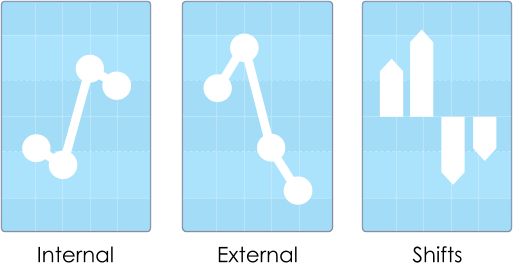Changes Across a Series
As we saw in The Basics of DISC Graphs, it is not unusual to see changes from one graph to another within a person's profile series. The important changes are those between the 'Internal' and 'External' Profiles, as we can see in the example below.

This rather extreme example describes a person who seems to be trying to fulfil a role completely at odds with their natural style. We can see this because the Internal Profile (the natural style) is considerably different from the External Profile (which describes the kinds of reactions that they feel are appropriate to their current circumstances, and particularly their work life).
In the diagram above, we have graphically illustrated the changes (or 'shifts' as they are more usually known) between these Internal and External Profiles. In this case, Dominance and Influence are shifting upwards, while Steadiness and Compliance shift downwards. This suggests a person trying to show themselves as more assertive and communicative than is actually the case, while also attempting to demonstrate a more urgent, responsive style (the downward shift in Steadiness) and a greater willingness to take the initiative (the shift in Compliance). As you might imagine, this type of pattern is not unusual in the modern workplace.
Each shift has a different significance - some are relatively common (such as the downward shift in Steadiness we saw above) while others can represent a more difficult adaptation. The size of the shift is also important. Small shifts of a few percent are very frequent, and unlikely to represent serious difficulties, while larger shifts (nominally, larger than twenty-five percent or quarter of the graph) will have greater significance. In this section, we list the eight possible shifts and comment on their likely implications.
|
|
Dominance Shifted UpwardsAn upward shift in Dominance suggests that the person concerned is attempting to present themselves as more direct and assertive than would normally be the case. This means that they perceive their role as requiring a more independent and self-motivated style than they are naturally comfortable with. This shift in Dominance is often difficult to maintain, and may result in stress over the long term. |
|
|
Dominance Shifted DownwardsThis effect indicates that a person is attempting to present themselves as less direct and assertive than would normally be the case. This means that they perceive their role as requiring a more submissive and compliant type of behaviour, often as a result of the need to work with even more highly Dominant individuals. Shifts in Dominance of this kind are not normally maintained in the long term, and more independent behaviour can be expected to develop. |
|
|
Influence Shifted UpwardsThis shift shows a perceived need for communication skills in an individual's current role, and they are displaying a more apparently confident and friendly approach than would normally be the case. The permanence of this shift varies according to circumstances - if the candidate perceives a positive response to this style, it is not unusual for it to continue in the long term, and the individual concerned may actually adopt this style as a true Internal factor. |
|
|
Influence Shifted DownwardsA downward shift in Influence suggests that there is a perceived need for formality and discipline in this person's current role, and they are displaying a more structured and organized approach than would normally be the case. Extremely outgoing individuals trying to mask their approach in this way often find it hard to maintain this style over long periods of time. |
|
|
Steadiness Shifted UpwardsThis shift suggests that a steady, persistent style seems to be needed in this individual's work or, at least, they perceive this to be the case. An upward shift in Steadiness might also suggest a feeling that they need to adopt a more amiable, receptive attitude, depending on circumstance. |
|
|
Steadiness Shifted DownwardsThis relatively common shift, seen often in individuals with relatively high Steadiness on their Internal Profile, simply reflects the need in many types of work to react responsively and perform tasks within set timescales. It is usual for a Steadiness shift of this type to persist over time, and it may even become a permanent feature. |
|
|
Compliance Shifted UpwardsWhere this shift appears in a profile series, a focus on fact and detail appears to be necessary for the person concerned, to the extent that they feel the need to demonstrate a higher aptitude for this type of work than might be natural to them. Compliance will increase while this shift is maintained, often accompanied by a corresponding drop in assertiveness or apparent self-confidence. |
|
|
Compliance Shifted DownwardsA drop in Compliance on the External Profile suggests that independence or self confidence appear to be necessary under this person's current circumstances, to the extent that they feel the need to demonstrate a higher level of these factors than might be natural to them. Levels of co-operation and caution will tend to decrease while this shift is maintained, as the individual is attempting to demonstrate their ability to work without support. |

